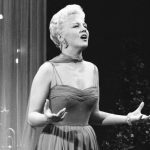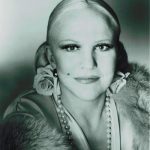Peggy Lee
Born: May 26, 1920 Died: January 21, 2002
What she did: Actress
- Photographed in 1950
- Peggy Lee. Photo: CBS Photo Archive/Getty Images
Facts:
- Peggy was born Norma Deloris Egstrom in Jamestown, North Dakota.
- After her mother died when Peggy was four, her father married Minnie Schaumberg Wiese but later left home, leaving Peggy’s care entrusted to a stepmother who physically abused her.
- Norma headed for Hollywood after she graduated from high school in 1938.
- With her she took $18 in cash and a railroad pass she had borrowed from her father.
- Although she got a brief singing engagement at the Jade Room, a supper club on Hollywood Boulevard, she made little impression on the film capital, and she was reduced to working as a waitress and as a carnival spieler at a Balboa midway.
- Deciding to try her luck nearer home, she found work as a singer over radio station WDAY in Fargo, North Dakota.
- The manager, Ken Kennedy, christened her Peggy Lee.
- Her prospects for a career brightened when she moved to Minneapolis, where she sang in the dining room of the Radisson Hotel, appeared on a Standard Oil radio show, and sang with Sev Olsen’s band.
- Peggy broke into the big time when she became a vocalist with Will Osborne’s band, but three months after she joined the group it broke up in St. Louis, and she got a ride to California with the manager.
- It was at the Doll House in Palm Springs, California that Peggy Lee first developed the soft and “cool” style that has become her trademark.
- Unable to shout above the clamor of the Doll House audience, Miss Lee tried to snare its attention by lowering her voice.
Quote from Discovering Great Singers of Classic Pop
Chatting and laughing, clanging cocktail glasses, the audience was louder than the band, as Peggy Lee tells the story. It was 1941, at a swanky club in Palm Springs called the Doll House. Lee was booming out her songs, but nobody seemed to care much about hearing her. Then she got a thought. For the next tune, whose title she doesn’t recall, she lowered her voice to a hush, quieter than the crowd, and the audience started settling down and listening. Apocryphal or not, the story nicely dramatizes the inverted emotional physics at work in Peggy Lee’s singing. By reducing how much she gives her listeners, she increases how much they get.
- There, she was noticed by bandleader Benny Goodman.
- According to Peggy, “Benny’s then-fiancée, Lady Alice Duckworth, came into The Buttery, and she was very impressed. So the next evening she brought Benny in, because they were looking for a replacement for Helen Forrest. And although I didn’t know, I was it. He was looking at me strangely, I thought, but it was just his preoccupied way of looking. I thought that he didn’t like me at first, but it just was that he was preoccupied with what he was hearing.”
- She joined his band in 1941 when the band was at the height of its popularity, and for over two years she toured the United States with the most famous swing outfit of the day, playing hotel engagements, college proms, theater dates, and radio programs.
- Much of her present success Miss Lee credits to her apprenticeship with the big bands. “I learned more about music from the men I worked with in bands than I’ve learned anywhere else,” she has said. “They taught me discipline and the value of rehearsing and even how to train…. Band singing taught us the importance of interplay with musicians. And we had to work close to the arrangement.”
- In 1942 Lee had her first No. 1 hit, “Somebody Else Is Taking My Place”, followed by “Why Don’t You Do Right?” which sold over 1 million copies and made her famous. She sang with Goodman’s orchestra in two 1943 films, Stage Door Canteen and The Powers Girl.
- In March 1943 Lee married Dave Barbour, a guitarist in Goodman’s band. Peggy said, “David joined Benny’s band and there was a ruling that no one should fraternize with the girl singer. But I fell in love with David the first time I heard him play, and so I married him. Benny then fired David, so I quit, too. Benny and I made up, although David didn’t play with him anymore. Benny stuck to his rule. I think that’s not too bad a rule, but you can’t help falling in love with somebody.”
- When she left the band that spring, her intention was to quit the footlights altogether and become Mrs. Barbour, fulltime housewife. In March, 1943, Peggy Lee married Dave Barbour, the guitarist in Goodman’s band; shortly thereafter she left the band. After her daughter, Nicki, was born in 1944, Peggy Lee and her husband worked successfully on the West Coast.
- It’s to Mr. Barbour’s credit that he refused to let his wife’s singing and composing talent lay dormant for too long. “I fell in love with David Barbour,” she recalled. “But ‘Why Don’t You Do Right’ was such a giant hit that I kept getting offers and kept turning them down. And at that time it was a lot of money. But it really didn’t matter to me at all. I was very happy. All I wanted was to have a family and cling to the children. Well, they kept talking to me and finally David joined them and said ‘You really have too much talent to stay at home and someday you might regret it.'”
- She drifted back to songwriting and occasional recording sessions for the Capitol Records in 1947, for whom she recorded a long string of hits, many of them with lyrics and music by Lee and Barbour, including “I Don’t Know Enough About You” (1946) and “It’s a Good Day” (1947).
- With the release of the US No. 1-selling record of 1948, “Mañana”, her “retirement” was over. In 1948, Lee’s work was part of Capitol’s library of electrical transcriptions for radio stations. An ad for Capitol Transcriptions in a trade magazine noted that the transcriptions included “special voice introductions by Peggy.”
- Following the completion of her contract run with Capitol, Miss Lee was signed by Decca Records where she remained for six years, returning to Capitol in 1958. At Decca, Lee produced the quintessential recording of “Fever,” perhaps her greatest recording and certainly one of the top songs to emerge from the early Rock N’ Roll period.
- In 1948 Lee joined vocalists Perry Como and Jo Stafford as a host of the NBC Radio musical program The Chesterfield Supper Club. She was a regular on The Jimmy Durante Show and appeared frequently on Bing Crosby’s radio shows during the late 1940s and early 1950s.
- In 1950 Peggy Lee made a first, brief screen appearance in Paramount’s “Mr. Music,” starring Bing Crosby.
- In 1953 she played a featured role opposite Danny Thomas in Warner Brothers’ remake of the early Al Jolson talking picture, “The Jazz Singer,” and won praise from a critic of the “New York Wolrd-Telegram and Sun” for “a very promising start on a movie career” as “a poised and ingratiating ingenue.”
- Her performance as a despondent and alcoholic blues singer in “Pete Kelly’s Blues” (Warner Brothers, 1955) won her a nomination from the Academy of Motion Picture Arts and Sciences. In the 1955 balloting conducted by the Council of Motion Picture Organizations, moviegoers voted her the “Audie” statuette.
- She provided speaking and singing voices for several characters in the Disney movie Lady and the Tramp (1955), playing the human “Darling” (in the first part of the movie), the dog “Peg”, and the two Siamese cats, “Si and Am”.
- In 1957, she guest starred on the short-lived variety program The Guy Mitchell Show.
- Critic George Hoefer of “Downbeat” magazine has called her “the greatest white female jazz singer since Mildred Bailey,” and Leonard Feather in “The Encyclopedia of Jazz” (Horizon, 1960) has described her as “one of the most sensitive and jazz-oriented singers in the pop field.”
- Miss Lee won the 1946 polls as best female vocalist of both “Metronome” and “Downbeat” magazines, wisely read by jazz buffs, and the 1950 citation as “the nation’s most popular female vocalist” from “Billboard,” a trade magazine of show business.
- A frequent performer on television, she sang on the Thursday night “Revlon Revues” over CBS-TV in 1960, and has appeared on televised musical variety shows starring Perry Como, George Gobel, Steve Allen and Bing Crosby. In March, 1960 she undertook a straight dramatic role in “So Deadly, So Evil” on the “General Electric Theater” over CBS-TV.
- In September, 1962 Miss Lee reached what she has called the “high spot” in her career when she was selected to appear in Philharmonic Hall of New York’s Lincoln Center for the Performing Arts, an auditorium usually available to those whom the management considers as serious artists. Miss Lee conducted research for, and wrote a program called “The Jazz Tree,” tracing the origins and development of jazz as a native American art form. Originally scheduled for December, 1962, the booking was postponed until March, 1963 to give Miss Lee enough time to perfect her presentation.
- This perfectionist approach to her programs is typical of Miss Lee. She polishes and perfects every aspect of her performances – her special coiffures, her costly wardrobe, her lighting, her entrances and exits, and her musical arrangements.
- Her perfectionism may derive from her association with Benny Goodman, who always demanded the best from his performers. Rejecting the improvisatory approach of most jazz singers, Peggy Lee plans every detail of her delivery in advance, including even the movement of her hands.
- This perfectionism has taken its toll of her health on several occasions; she was hospitalized with virus pneumonia in July, 1958 and in November, 1961. As a result, Miss Lee has reduced her schedule, confining her public appearances to six weeks each year in New York and Las Vegas, a few television shows, and one or two charity benefits.
- Lee continued to perform into the 1990s, sometimes confined to a wheelchair.After years of poor health, she died of complications from diabetes and a heart attack on January 21, 2002, at the age of 81.
- She was cremated and her ashes were buried in a bench-style monument in Westwood Village Memorial Park Cemetery in Los Angeles.
Phryne (FRY-KNEE)
Born: 371 BC Died: January 21, 2002
What she did: Courtesan
- by José Frappa. Phryne is depicted baring her breasts before the jury.
- PHRYNE by Jean Alexandre Joseph Falguière
- Phryne at the Poseidonia in Eleusis by Henryk Siemiradzki, c. 1889. Phryne is shown naked, preparing to step into the sea.
Facts:
- Phryne, was born as Mnesarete in around 371 BC in Ancient Greece.
- Though her birth name was Mnesarete, she was given the nickname Phryne which meant “toad.” This was partly because she had a yellowish complexion and because this was a common nickname given to sex workers.
- Phryne was a sex worker living in Athens. She was known for her exceptional
beauty, so she was very successful. - Her beauty inspired a variety of artworks. During a festivals, Phryne would let down her hair and walk naked into the ocean. It is said that this inspired the artist Apelles to create his painting Aphrodite Anadyomene which depicts the Greek goddess of love, Aphrodite’s birth from the sea.
- Sculptor Praxilteles used her as the model for his sculpture Aphrodite of Knidos
- ONE THE FIRST NUDE STATUES OF A WOMAN FROM ANCIENT GREECE. This was a big deal because the art world was dominated by heroic male nudity at the time. The nudity was so controversial at the time that the city of Cos that originally commissioned it refused to take it. However, the city of Knidos bought it and it
became such a popular tourist attraction, the entire city managed to pay off its debt. - Phryne was the model for more of Praxilteles’ sculptures, including one that depicted Eros, the Greek version of cupid, and one of Phryne herself that was made of SOLID FUCKING GOLD and placed in the temple of Delphi.
- When philosopher Crates of Thebes saw the gold statue, he called it “a votive offering of the profligacy of Greece.”
- Phryne made bank as a sex worker and model. She was apparently so rich that after the walls of Thebes were destroyed by Alexander the Great in 336 BC, she offered to pay to rebuild them on one condition; that the walls be inscribed with the message “Destroyed by Alexander, Restored by Phryne the Courtesan.”
- However, the city rejected her offer because the idea that a woman, let alone a sex worker, could rebuild the walls that a powerful man destroyed, was emasculating to the male leaders of the city.
- Most of what we know of Phryne is from writer Athenaeus (Athen-aus). He wrote of her once: “Phryne was a really beautiful woman, even in those parts of her person which were not generally seen: on which account it was not easy to see her naked; for she used to wear a tunic which covered her whole person, and she never used the public baths. But on the solemn assembly of the Eleusinian festival, and on the feast of the Poseidonia, then she laid aside her garments in the sight of all the assembled Greeks, and having undone her hair, she went to bathe in the sea.”
- Sometime during her life Phryne faced a capital criminal charge. We don’t know what she was charged with, but some records suggest it was impiety, or a lack of reverence for the gods.
- Her defender was the great orator Hypereides who was also one of her clients.
- Now, in ancient Greece, beauty was likened to favor from the gods. If you were born beautiful, you must be blessed.
- So, when things weren’t looking good for her, Hypereides removed Phryne’s robe and basically told everyone to look at her breasts.
- Not wanting to be smited by the gods, the judges acquitted Phryne.






